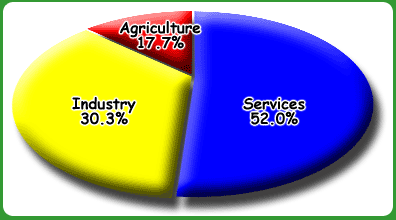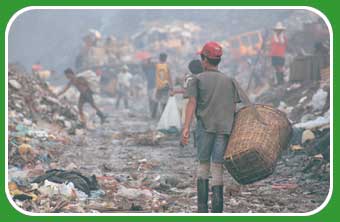| � |
The People

Today, 60% of Filipinos
are 15 years old or younger. With a population growth rate
of 2.36%, the population could double in the next 35 years.
To keep pace, the country will need to create one million
new jobs every year. Other services such as roads, hospitals
and schools will be stretched to the limit too. But influential
Catholic church leaders condemn the use of artificial contraceptives
like the pill and the condom. Consequently, less than half
the population use artificial contraceptives which can lead
to unwanted pregnancies. 400,000 abortions have been performed
illegally, often without proper medical care.

� Nancy Durrell McKenna/Panos
Pictures. |
Politicians
are now focusing on the role of women in bringing down
the birth rate by giving them more choice over the size
of their families Filipino governments in the 1990s did
invest more in family planning schemes to bring down the
birth rate. However, newly elected President Arroyo has
spoken more in favour of natural contraception which may
reverse these trends. |
 for
a spreadsheet showing data for the population of The Philippines
over time. Construct a line graph to show this data. If you
need help with this, click on for
a spreadsheet showing data for the population of The Philippines
over time. Construct a line graph to show this data. If you
need help with this, click on  (this
will open a word file which you can save and/or print) (this
will open a word file which you can save and/or print)
For more information
and data on the population of The Philippines, including details
of the country's census in 2000 and information on the different
regions, visit, www.census.gov.ph/census2000/index.html
The Economy
Employment
Structure

Source: World Bank 1999
The Philippines is one
of the poorest countries in South-East Asia. In rural areas,
farm productivity is low and a lack of other job opportunities
has encouraged many Filipinos to move to cities in search
of work. Others have moved abroad to earn money as maids,
nurses or construction workers, including the UK. Many of
these migrant workers suffer great hardship in order to save
money to send to their families back home.
| On
Smoky mountain on the outskirts of Manila, life is extremely
harsh. Thousands of people live amongst the rubbish dumps,
sifting through garbage to find things to sell. It is
people like these who are worst hit by the country's debt
problem as health and education services are cut back.
|

� Marc Schlossman/Panos Pictures.
|
The Burden of Debt
Although the government is determined to match the pace of
development in neighbouring newly industrialised countries
(NICs) like Malaysia,
the country's debt is a major obstacle. Roughly 20% of the
government's budget ($5 billion) is spent on paying interest
on overseas debts, more than is spent on health and education
combined.

� C.Stowers/Panos Pictures
|
To
pay off the debt, Filipinos are rapidly using up the country's
natural resources, like cutting down forests to produce
timber for export. However, there are a growing number
of 'debt for nature' schemes arranged with other governments
and international banks so that debt is written off in
exchange for environmental protection. |
As part of a programme to
pay back the debt, the International Monetary Fund has encouraged
the Filipino government to remove many rules and regulations
for businesses in order to attract more investment from overseas.
This way, the country can produce more goods for export, earning
more money. 250 companies have located factories in five tax-free
'export
processing zones', assembling electronic equipment and garments,
and processing foods for export. This type of work is labour-intensive,
providing jobs for many people, although many of these jobs
are poorly paid.
Find out more about
export processing zones by visiting www.globaleye.org.uk/secondary_summer/focuson/case-fash.html
|
� |





